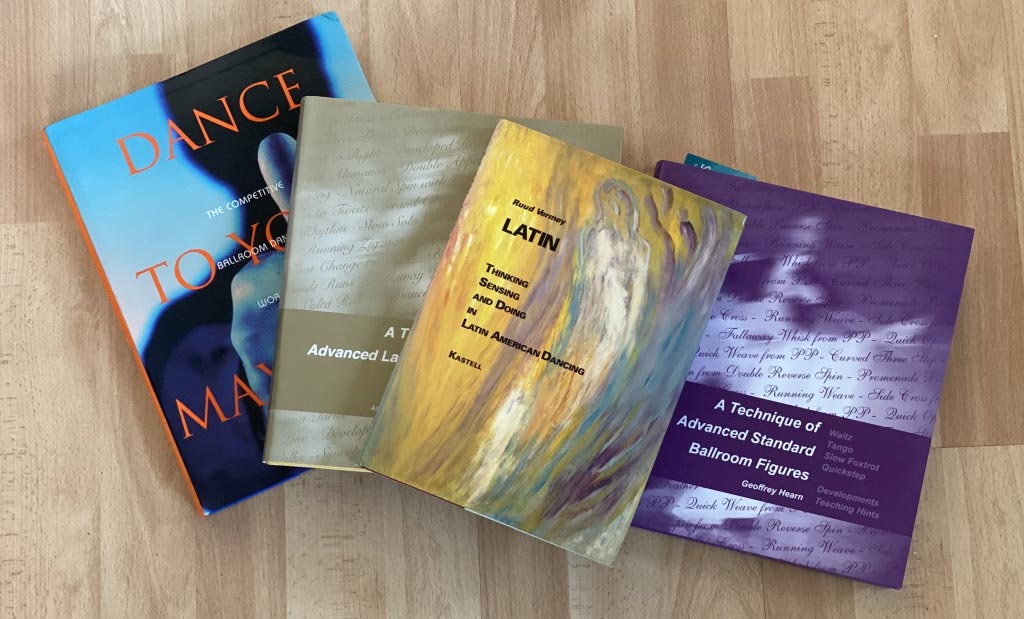We’re now about three weeks into this unprecedented worldwide period of isolation and social distancing. Dancers are feeling like all their skills are already atrophied and they fear that they’ll forget everything they knew by the time this all gets put behind us.
Don’t get discouraged. In the book Ballroom Icons, author Brigitt Mayer describes a period following WWII when dancers would sew costumes out of parachutes and gentlemen would dye army uniforms to look like tail suits. Couples turned burned-out buildings destroyed by falling bombs into makeshift dance floors (see pages 70-71). Yet these were the years when some aspects of ballroom dancing developed more than at any other time. Where there’s a will, there’s a way!
There are a number of things that you can be doing to keep growing as a dancer during this crazy period in history. This post will explore some of your options.
Following WWII dancers would sew costumes out of parachutes and gentlemen would dye army uniforms to look like tailsuits. Couples held practice sessions in burned-out buildings destroyed by falling bombs.
Video Training
The dance community quickly jumped into the use of video technology to provide additional training resources for dancers. Some teachers and studios have been posting short exercises to their social media accounts that you can do at home.
Other studios have focused on an ongoing series of lessons, like the outstanding Coronavirus Daily Vlog by Joel Marasigan of JC Dance Co in Vancouver. The material in these sessions is really good, covering everything from breathing dynamics to specific technique for some of the more misunderstood figures, including basic figures. For some steps, Joel covers technique for beginners, then moves on to more details for intermediate dancers and finishes with even more specific advice for advanced dancers.
View Coronavirus Daily Vlog on YouTube
Wayne Eng of Dance Vision has been posting a series of Dance From Home video lessons from some of the world’s top dancers. These are presented live but you can watch the videos at any time after the live session is over. To get information like this from teachers of this caliber would normally cost you a considerable sum of money, so we are indeed fortunate to have resources like this available to us. Luca and Daria Baricchi give great insight on the origins of the terms Natural and Reverse. Andre and Natalie Paramonov give a beautiful explanation of the difference between American Rhythm and International Latin leg action. Yegor Novikov gives some great exercises for working on using the feet and legs properly in Latin dances like the Rumba. And there is so much more. Outstanding material and easy to learn from even in the small amount of space you have at home.
View Dance Vision’s Dance From Home videos on YouTube
Another resource that provides some useful content is the Ballroom Mastery series. These are lessons covering material originally requested by dancers writing in with their suggestions.
View Ballroom Mastery TV on YouTube
There are of course lots of free resources available on YouTube and these have existed for some time. Some of the material online is questionable, so you have to sort through what is accurate and what isn’t, but the above series are based on proper technique by professionally certified teachers.
Other studios have been developing content more specifically focused on a paid membership structure. Delta Dance follows this approach. Our feeling is that as the world increasingly moves to embrace video as a valid learning tool, the economic model must also move in that direction or all dance teachers will eventually just be giving away their work for free. And since it costs thousands of dollars (typically tens of thousands or even hundreds of thousands in the case of top champions who are passing along years of learning and experience) it makes no sense to simply give it away with no commitment in return from those who benefit from the work involved. For this reason we certainly welcome and agree with those studios that are looking ahead at economic systems that make sense for their long-term success.
Among these are DanceSport Life Academy, which originated with a leading-edge program featuring Mirko Gozzoli and Edita Daniute last year. The program has expanded to include lectures from many top teachers including Richard Gleave, Hazel Newberry, Slavik Kryklyvyy and others. The program is subscription based with discounts for members on individual courses, or you can buy the lectures you want.
Learn more about Dancesport Life Academy
Aria Ballroom in Seattle has also taken a subscription-based model for online classes. The high quality videos featuring studio owners Simeon Stoynov and Kora Stoynova cover a variety of dances in different skill levels. Lesson 1 in each category is available at no charge with additional lessons available to paid subscribers.
View Aria Ballroom Online Academy on YouTube
Dance Books

There are some excellent books that you can plunge into during this isolation period. I’m currently re-reading Alex Moore’s classic work “Ballroom Dancing.” Although it dates way back to 1936 and contains much of the content in our ISTD technical guides that has long since been refined, Alex goes into a lot of useful detail. The book has a surprising number of useful gems for those who teach beginners, social dancers and intermediate level competitors.
Another book you might want to look up if you’re an advanced dancer is “Dance to Your Maximum” by Maximiliaan Winkelhuis. This classic workbook for competitive dancers stands alone for its usefulness. Be prepared to pay a pretty penny for this out-of-print book. On Amazon it’s priced from $170+.
Then there are the two excellent technical guides by Geoffrey Hearn, “A Technique of Advanced Latin-American Figures” and “A Technique of Advanced Standard Ballroom Figures.” These are basically the same as the ISTD books in concept, but cover advanced figures that are not included in the standard technique manuals. Like the above, they are pricey because they are so hard to get but you might find one in a used book store or a local dance shop.
There’s also Ruud Vermey’s classic work “Latin: Thinking Sensing and Doing in Latin American Dancing.” Filled with theory, this book covers many aspects of the psychology and principles of Latin dance. Fortunately, this one is still available at a reasonable price.
Finally, there is the classic coffee table work by Brigitt Mayer titled “Ballroom Icons.” I never get tired of this book and pore over it at least once a year. Brigitt spent years interviewing the greatest names in ballroom dancing, many who are no longer with us, to get their stories. In the process, her work is a thorough look at the history of the development of ballroom dancing. Printed on archival paper, it comes in a lovely slip case that will keep for decades. Worth every penny. I have a spare copy, autographed by Brigitt, that I purchased from her at last year’s Delta Cup. I’m willing to sell it at my cost to anyone local.
Cross Training
You may not be able to go out social dancing or attending competitor practices, but that doesn’t mean you can’t be preparing your body for that day when we’re all allowed back in public. Consider cross training to keep yourself fit.
I’m an avid cyclist and try to either get outside on my bike or riding on my indoor smart trainer every day in order to keep up my stamina levels. You may not be able to go to the gym but you can do comprehensive workouts at home that don’t even require any equipment. You do, however, need to bring your personal motivation so that you can create a schedule for staying fit and stick to it.
There are lots of great apps and videos available showing you different ways to stay in shape, whether you have a gym at home or not. You’d be surprised how effective the old stand by exercises like pushups, Russian Twists and tricep pushdowns on the seat of a chair can be. Use the edge of a stair to do calf raises to keep your calves in shape. Do squats holding your frozen Easter turkey if you have to.
Stay safe and healthy and stay positive. Eventually all of this will be behind us. Eventually your studio will reopen, dance competitions will be back on the calendar and we’ll return to our favorite activity.














